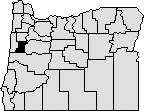
Benton County was established by the Provisional Legislature in 1847. It was named
for Senator Thomas Hart Benton of Missouri, who was instrumental in promoting the development of the Oregon Country.
Carved from Polk County, Benton County stretched from the Polk County boundary south to the California border and from the Pacific Ocean east to the Willamette River. Umpqua, Lane, Douglas, Jackson, Lincoln, Josephine, Curry and Coos Counties were created from portions of the original Benton County. Today Benton County occupies 679 square miles of the central Willamette Valley and is bordered on the east by the Willamette River and Linn County, on the west by the summit of the Coast Range and Lincoln County, on the north by Polk County, and on the south by Lane County.
The city of Marysville, later renamed Corvallis, became the county seat in 1851. The first county courthouse was erected in 1854. The second courthouse, built in 1889, is the oldest in Oregon that is still used for its original purpose. It was extensively renovated in 1976 to restore and preserve the historic character of the building. The courthouse now houses state circuit court offices and a few county offices. Most county offices are located in other buildings in Corvallis.
At the time of its creation, Benton County government consisted of two or more justices of the peace acting as county commissioners; a judicial system including circuit, probate, and justice courts; clerks for each court; law enforcement offices of sheriff and coroner; and the tax and finance offices of the assessor, tax collector, and treasurer. In 1972 a home rule charter was passed in Benton County and the governing body of the county became a three-member board of commissioners.
The Mary's River Band of the Kalapuya ceded the lands in present Benton County to the United States in the ratified treaty of Jan. 22, 1855.
The Corvallis Academy was incorporated in 1858; the school later became the Corvallis State Agricultural College in 1872 and is known today as Oregon State University. Along with the university, agriculture, lumber and wood products, and electronics form the economic base of the county. The 2018 population of 93,590 was an 9.4% increase over the 2010 population.